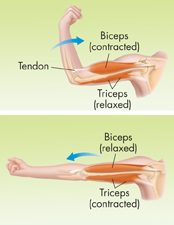Quick Lab
GUIDED INQUIRY
What Do Tendons Do?

Put on gloves and an apron. Place a chicken wing on a paper towel. Peel back or cut away the skin and fat of the largest wing segment to expose the biceps. CAUTION: Do not touch your face with your hands during the lab.
Find the tendon that attaches the biceps to the bones of the middle segment of the wing.
Use forceps to pull on the tendon of the biceps and observe what happens to the chicken wing.
Clean your tools and dispose of the chicken wing and gloves per your teacher's instructions. Wash your hands.

Observe What happened when you pulled on the tendon? In a live chicken, what structure would pull on the tendon to move the wing?
Compare and Contrast Observe the back of your hand as you move each finger. How is the way the wing moves similar to the way your fingers move?
Analyze and Conclude
Muscles and Movement
 How do muscle contractions produce movement?
How do muscle contractions produce movement?
One of the most confusing concepts to understand about muscles is that they can produce force only by contracting in one direction. Yet, you know from experience that you can use your muscles to push as well as to pull. How is this possible?
How Muscles and Bones Interact Skeletal muscles are joined to bones by tough connective tissues called tendons. Tendons are attached in such a way that they pull on the bones and make them work like levers. The joint functions as a fulcrum—the fixed point around which the lever moves. The muscles provide the force to move the lever. Usually, several muscles that pull in different directions surround each joint.  Skeletal muscles generate force and produce movement by pulling on body parts as they contract.
Skeletal muscles generate force and produce movement by pulling on body parts as they contract.

FIGURE 32–10 Opposing Muscle Pairs By contracting and relaxing, the biceps and triceps in the upper arm enable you to bend or straighten your elbow. Apply Concepts Which skeletal muscle must contract in order for you to straighten your elbow?
dWe can use our muscles to push as well as to pull because most skeletal muscles work in opposing pairs. When one muscle in the pair contracts, the other muscle in the pair relaxes. The muscles of the upper arm shown in Figure 32–10 are a good example of this dual action. When the biceps muscle contracts, it bends, or flexes, the elbow joint. When the triceps muscle contracts, it opens, or extends, the elbow joint. A controlled movement requires the involvement of both muscles. To hold a tennis racket or a violin requires a balance of forces between the biceps and the triceps.
This is why the training of athletes and musicians is so difficult. The brain must learn how to work opposing muscle groups in just the right ways to make the involved joints move precisely.
 In Your Notebook Explain in your own words the role of opposing pairs in muscle contraction.
In Your Notebook Explain in your own words the role of opposing pairs in muscle contraction.
Table of Contents
- Formulas and Equations
- Applying Formulas and Equations
- Mean, Median, and Mode
- Estimation
- Using Measurements in Calculations
- Effects of Measurement Errors
- Accuracy
- Precision
- Comparing Accuracy and Precision
- Significant Figures
- Calculating With Significant Figures
- Scientific Notation
- Calculating With Scientific Notation
- Dimensional Analysis
- Applying Dimensional Analysis




